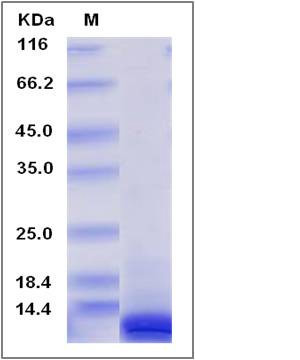Human CXCL10 / Crg-2 Protein
C7,crg-2,gIP-10,IFI10,INP10,IP-10,mob-1,SCYB10
- 100ug (NPP1216) Please inquiry
| Catalog Number | P10768-HNAE |
|---|---|
| Organism Species | Human |
| Host | E. coli |
| Synonyms | C7,crg-2,gIP-10,IFI10,INP10,IP-10,mob-1,SCYB10 |
| Molecular Weight | The recombinant human CXCL10 consists of 78 amino acids and predicts a molecular mass of 8.8 KDa. It migrates as an approximately 9 KDa band in SDS-PAGE under reducing conditions. |
| predicted N | Met |
| SDS-PAGE |  |
| Purity | > 90 % as determined by SDS-PAGE |
| Protein Construction | A DNA sequence encoding the mature form of human CXCL10 (Q9UBH0) (Val22-Pro98) was expressed, with a N-terminal Met. |
| Bio-activity | |
| Research Area | Immunology |Inflammation / Inflammatory Mediator |Neuroinflammation |
| Formulation | Lyophilized from sterile PBS 1. Normally 5 % - 8 % trehalose, mannitol and 0.01% Tween80 are added as protectants before lyophilization. Specific concentrations are included in the hardcopy of COA. |
| Background | CXCL10, also known as crg-2, is a chemokine of the CXC subfamily and ligand for the receptor CXCR3. CXC chemokines are particularly significant for leukocyte infiltration in inflammatory diseases. CXCL10 has a three-dimensional crystal structure. Its signaling is mediated by the g protein-coupled receptor CXCR3, which is expressed on activated T cells and plays an important role in directing the migration of T cells, especially during Th1 responses. Binding of CXCL10 to CXCR3 results in pleiotropic effects, including stimulation of monocytes, natural killer and T-cell migration, and modulation of adhesion molecule expression. It is chemotactic for monocytes and T-lymphocytes. CXCL10 can be secreted by several cell types in response to IFN-γ. Baseline pre-treatment plasma levels of CXCL10 are elevated in patients chronically infected with hepatitis C virus (HCV) of genotypes 1 or 4 who do not achieve a sustained viral response (SVR) after completion of antiviral therapy. |
| Reference |
